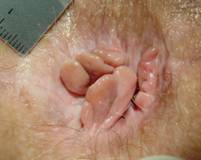Have you been using too much toilet paper because of pesky anal tags? Hemorrhoidal skin tags are flaps of skin or flesh found around the anus. They often form as a result of an existing hemorrhoid.
Anal tags are the shapeless lumps and flaps of skin and tissue found at the anal verge. They’re quite common and usually come with other anorectal problems, such as hemorrhoids.
 Anal skin tags often occur if an individual heals the thrombosed external hemorrhoids at home without surgery, the thrombosed hemorrhoids may leave behind skin tags. Anal sentinel tags may also form because of non-hemorrhoid causes, such as anal fissure, surgery, or infection, etc.
Anal skin tags often occur if an individual heals the thrombosed external hemorrhoids at home without surgery, the thrombosed hemorrhoids may leave behind skin tags. Anal sentinel tags may also form because of non-hemorrhoid causes, such as anal fissure, surgery, or infection, etc.
Despite the fact that people often confuse them with cancerous growths, skin tags are benign and present no serious health concerns.
Hemorrhoidal skin tags often don’t cause significant rectal symptoms, but they often affect the cleansing after bowel movement. If feces become trapped beneath the skin tags, it can cause irritation and lead to itching and further inflammation. Skin tags can also cause pain when it flairs up or if there’s another underlying rectal problem.
Patients suffering discomfort or itching due to hemorrhoidal skin tags can treat the condition with the following:
- Thorough cleaning of the affected area after bowel movement. May use gentle cleansers, such as witch hazel or aloe vera extract.
- Do a Sitz bath with warm water.
- May use OTC hemorrhoid cream to reduce irritation and swelling.
- If the skin tags frequently cause symptoms, individuals may consider having them removed surgically.
- Most patients who have anal tags often have hemorrhoids, too, they should consider complete care by treating internal hemorrhoids before removal of anal tags or at the same time.
Excision of anal tags:
Anal tags can easily be removed in the office using local anesthetic. A radiofrequency device is used to get rid of skin tabs and resurface the anal area to acquire a good cosmetic result. The procedure takes less than 10 minutes and patients are safe to drive immediately afterwards. There may be mild postoperative pain and discomfort with bowel movement in the first week. The patients are typically able to go back to work next day although the whole healing process may take a few weeks. If the patient needs a hemorrhoidectomy, anal tags can be removed together as part of hemorrhoidectomy. If the anal tag is extensive, two stages of surgery may be necessary to avoid anal stenosis.




